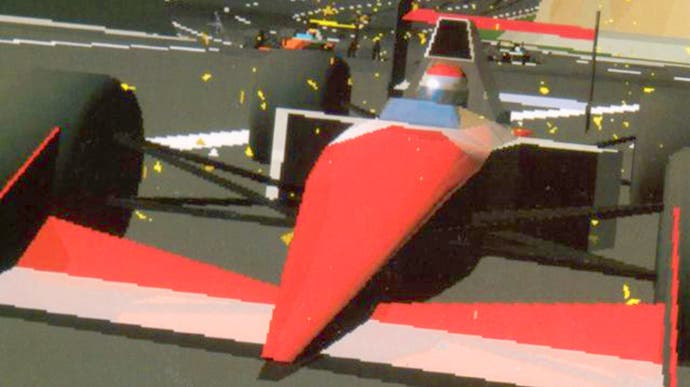Beyond 'arcade perfect' - Virtua Racing is a triumph on Switch
UPDATE: Now available in the UK, EU and US.
The Switch port of Virtua Racing first appeared on the Japanese Nintendo eShop at the beginning of the March. It's now available in all key territories, so we thought we'd republish our existing coverage to remind you about what makes this conversion so great.
First released in 1992, Virtua Racing ushered in a new era for Sega trading super-scaler technology for full on 3D polygon graphics and now, thanks to the wizards at Japanese developer M2, Virtua Racing returns for Nintendo Switch - and if you're into arcade racing, I highly recommend that you check it out. This new Sega Ages release replicates and enhances AM2's original masterpiece while introducing support for higher resolutions, higher frame-rates, increased draw distances and local split-screen for up to eight players.
The choice of Virtua Racing for the full-on M2 treatment is inspired. During the heyday of the arcade, companies such as Namco and Sega moved into the pseudo-3D space releasing new, more advanced games at a regular interval. Classics such as Pole Position from Namco and 1986's seminal Outrun really set the standard for what a driving game could be. With the camera placed behind the car, it was now possible to deliver a more realistic three-dimensional experience even if these games ultimately relied on 2D sprites. By the end of the decade, however, companies were beginning to experiment with real 3D graphics using polygons. This almost experimental time resulted in some expensive and exotic machines that produced convincingly 3D visuals at a relatively low frame-rate. It was a magical time.
Virtua Racing arrived in August 1992 and single-handedly ushered in a new era for Sega and real-time 3D graphics. It wasn't the first polygonal racing game, but it offered key improvements that made for something far more impressive than anything released prior. Virtua Racing was the first game created for Sega's new CG Board - later christened Model 1 when development on the next-generation Model 2 board began. Sega developed Model 1 internally starting in 1990 aiming to best Namco's System 21 board, which powered various polygonal games including titles such as Winning Run.
Virtua Racing itself started as an experiment designed to test the hardware's capabilities, but the idea was too good to sit on and it was ultimately developed into a full game. Through a modern lens, however, it may not seem like much but for 1992, it was a revelation. Simply put - it was the smoothest, most detailed polygonal game anyone had laid eyes on. It looked and moved unlike anything else.Part of this stems from performance. The expensive CG board could display the fully 3D environments of Virtua Racing at 30 frames per second - double that of Namco's earlier Winning Run. While this would quickly be superseded with the even more impressive Daytona USA, it was an important step in delivering fluid gameplay in a 3D world.
Secondly, while Virtua Racing relies entirely on flat-shaded polygons, the number of polygons used to build its world and vehicles was a step up from any other 3D game at the time. Then there is the cabinet itself - in its deluxe format, Virtua Racing is, as far as I can determine, the first arcade game designed with a 16:9 widescreen monitor. Monitors and televisions of this era were almost universally 4:3 but this widescreen display truly opened the field of view leading to a more immersive experience.
All of this is backed by the expected AM2 gameplay with tight handling and excellent track design. It was a true milestone for 3D racing games and it never truly received the home conversion it deserved - until now. It's for this reason that the Nintendo Switch version of Virtua Racing is so welcome - M2 set out to build a version of Virtua Racing that recreates the original arcade experience while offering key enhancements. M2 itself has long wanted to tackle this project - Virtua Racing was initially in development for 3DS, in fact, as part of the Sega 3D Archives series but it was decided to can the project due to budget and time constraints.
With the Switch version, M2 has focused on delivering what I might call 'arcade plus' - a version of Virtua Racing that replicates yet enhances the original arcade game. The process was seemingly difficult but, thanks to retrieval of the original source code by Sega's Rieko Kodama, the team was able to accurately simulate the game. The first key enhancement is resolution - the arcade game runs at a resolution of 496x384, which was quite a high-resolution for 1992, but the Switch version makes the jump to full 1080p in docked mode and native 720p in portable. M2 opted to avoid using any form of anti-aliasing instead allowing pixels to run free producing a very sharp image. Like the original, transparency is handled using a mesh pattern but, when viewed at such high-resolutions, the effect is surprisingly convincing.
Unfortunately, side by side comparisons reveal one flaw in the conversion - colour reproduction. The darker hues of the original game appear lighter on Switch with the red car taking on a pinkish hue. It's not entirely clear why this is the case as it doesn't seem like something M2 would have fumbled so perhaps it's intentional? Thanks to the flat shaded design of the game, however, the change in color still produces a pleasing image. One thing to keep in mind is that Model 1 draws polygons in a different manner. Like other Sega 3D hardware that would follow, Model 1 draws uses quads as primitives rather than triangles like hardware today. Polygons are also sorted differently - rather than using a Z-buffer, the sorting method here is less precise, resulting in visible intersection errors that is part of the charm of Model 1 visuals. M2 has replicated this perfectly on Switch, which I feel is key in capturing the aesthetic.
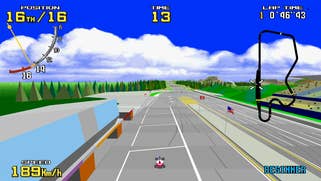
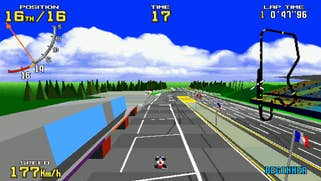

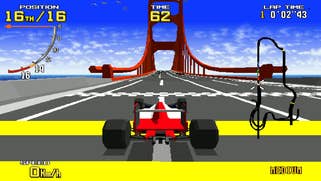
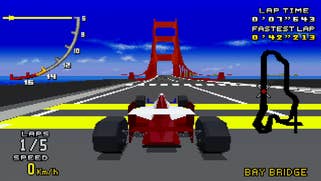
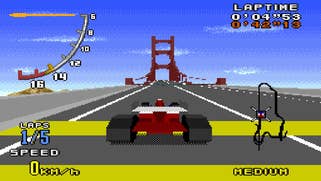
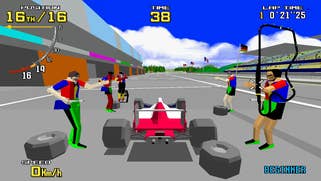
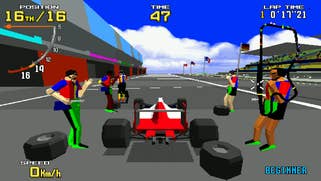
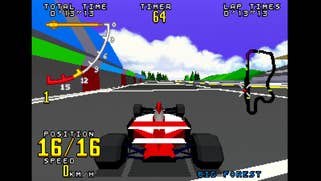
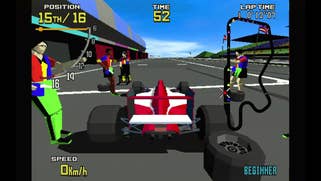
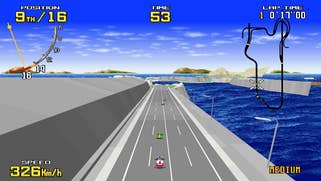

Perhaps the most impressive upgrade lies in how the map is drawn - the original clips polygons at a certain distance to reduce overall load on the hardware but on Switch, the entire track is always drawn. You can see far into the distance during every race. This does reveal limitations in the original modelling, of course, but the effect is impressive and welcome. At the same time, all bitmapped 2D elements are pulled directly from the arcade and scaled using nearest neighboru - at least in single-player mode. The clouds and text are razor sharp and perfectly match the original game.
Another impressive change is the bump in frame-rate - according to M2, this was one of the most challenging aspects of the project. Virtua Racing was coded to run at 30 frames per second and dramatic changes were required to increase the frame-rate without breaking the game. Background objects still update at a lower rate but the overall performance level is increased resulting in a more fluid experience all around. Of course, this also brings us to one of the most interesting features - large scale split-screen play. Like the original arcade game, which could support eight units linked together, the Switch version allows eight people to play on a single machine. The frame-rate is dropped to 30 frames per second but the results are remarkable.
M2 uses two CPU cores in this mode with each core emulating the equivalent of four Model 1 boards. This mode requires players to use the Joycon in horizontal mode, however, and during testing, we found that Joycon drop-out was a real problem so mileage may vary should you organise your own eight-player match-up. Still, when it works, it's a remarkable addition and unlike anything we've seen to date. If you have a large enough TV, the size of each window is surprisingly reasonable too.
Content wise, the Switch version features only the tracks and vehicle from the arcade game - the team investigated the possibility of including the extra tracks from the 32X version but the collision and track data is not compatible with the arcade game - meaning that working those tracks into the game would require a complete 'from the ground up' recreation, which was beyond the scope of this project. Another important detail is the audio - the original sound has been replicated and it sounds great, but in typical M2 fashion, the team has gone above and beyond the call of duty. The new replay mode, for instance, features a song from the 32X version, recreated on Switch using the specification of the arcade board's audio hardware.
It's this attention to detail that defines an M2 conversion and it's just one of many reasons why I feel this release of Virtua Racing is now the definitive version. It's packed with features; the handling is better than any home version before it and it just looks fantastic - and of course, there have been many console conversions in the past. The Switch game is only available on the Japanese eShop right now, but a Western release must surely be on the cards - regardless, it's still pretty easy to set up a JP account and grab it right now if you can't wait.
Beyond that, there are alternatives for a decent Virtua Racing fix. Arcade emulation is an option, of course, but after seeing the Switch version, you may feel underwhelmed. The PlayStation 2 release, known as Flat Out adds enhanced visual effects, and bumps frame-rate to 60fps. Draw distance is also slightly boosted from the arcade original and geometry appears to have been enhanced. One thing is clear though - unlike the Switch release, I'd wager that this version was coded from the ground up for PS2 rather than utilising any code from the Model 1 original. It's good but doesn't feel authentic - but it does look phenomenal running at 8x resolution under PCSX2 emulation.
Going back further in time, the original Mega Drive conversion may look rather spartan, but it's an amazing effort for the time. Its 3D visuals were achieved on a 16-bit system by embedding an additional custom DSP chip based on the Samsung SSP160x. This chip contains an arithmetic logic unit running at 23MHz, supporting upwards of 9000 polygons per second - a far cry from the 180,000 polygons per second of the Model 1 board. Regardless, the development team was able to create a surprisingly faithful conversion that features all three tracks, albeit with significant cuts and a 15fps frame-rate. It's jerky by today's standards, but smoother than any SuperFX Nintendo game.
The Mega Drive 32X's Virtua Racing Deluxe delivers its own unique take with extra courses and vehicles, and it's one of my favorite conversions. It also offers a noticeable increase in quality over the original Mega Drive release. Car and world detail is boosted while the colour palette is increased to take advantage of the 32X hardware. It's a much cleaner, smoother looking game overall even if it still falls short of the arcade game by a wide margin. Like the Mega Drive version, collision detection is pared back compared to the arcade and Switch versions while elements like the pit crew disappear immediately at the start of the race. The frame-rate is bumped up from 15fps to 20fps in this version, making for a more playable game while audio quality takes advantage of the 32X's hardware. For years, this was the best version of Virtua Racing you could enjoy at home and, while it's a bit sluggish today, it still holds up remarkably well. Time Warner's Saturn port? Well, that's best not mentioned.
There are some good Virtua Racing ports available, but for my money, M2's Switch release is by far and away the best option. It has a level of authenticity that's untouchable, while at the same time modernising the game to look great either on a living room display, or on the mobile screen when gaming on the go. Add in the local multiplayer options and it's an unmitigated success. If you miss great arcade racing games and own a Switch, I'd say that this is a must buy. M2 is making magic here and Virtua Racing is yet another feather in its cap - and with this attention to detail in mind, I can't wait to see the developer's efforts with the upcoming Mega Drive mini.
